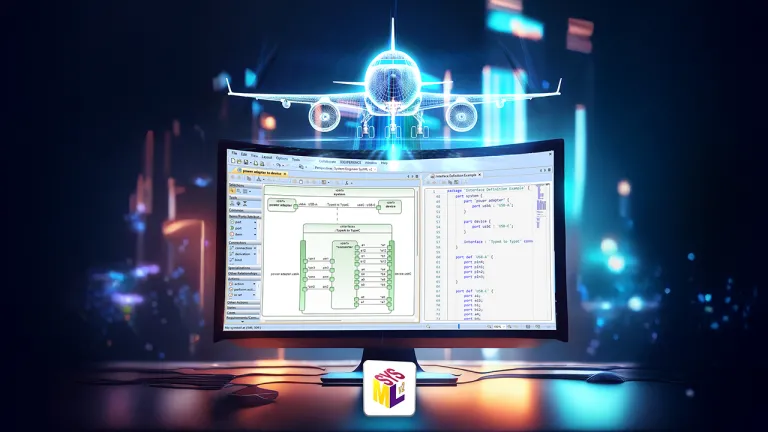No Magic
Provides Standard-based Modeling Solutions for Analyzing, Designing, Simulating Systems of Systems.
Leading the Way in Systems Engineering and Modeling
No Magic offers a range of software products and tools in model-driven engineering, system architecture, system design, and software engineering. It is crucial for organizations to comply with specific industry standards and regulations. No Magic enables users to create models that are aligned with international modeling and system engineering standards.
Discover CATIA SysML v2 Early Experience Program
Through the Early Experience Program, participants gain early access to the implementation of the OMG SysML v2 standard across the CATIA Magic and No Magic (Cameo) product lines and alongside SysML v1.
- 100% Standard Conformance to the OMG SysML v2 specification metamodel
- Synchronized Textual and Graphical Authoring
- Extensibility and Customization adaptable to meet unique user needs
- SysML v2 REST API Integration to enhance interoperability
- Model evaluation
To join the CATIA SysML v2 Early Experience Program
- Install CATIA Magic/No Magic 2024x Refresh2 Desktop Client
- The designated Point of Contact (POC) from your organization should contact CATIA.EMEAR.sysml2-eep@3ds.com
The early release of SysML v2 capabilities by Dassault Systèmes is a significant step forward for MBSE adoption across industries. It empowers our users to explore the full potential of this next-generation standard, test its application in their workflows, and strategically plan for a smooth transition
Comprehensive Toolset for Model Based Systems Engineering
No Magic offers a wide range of tools and products to support various aspects of model-driven engineering and systems engineering.
Driving Systems Integration with No Magic Modeling Solutions
Our modeling solutions assist in the development, integration, and analysis of complex systems, making them a valuable resource for engineers and organizations working on Systems of Systems (SoS) projects.
Empowering Systems Engineering with No Magic Plugins
Our extensive array of plugins empower organizations to tackle the complexities of systems engineering and modeling effectively
Certified for Automotive Functional Safety Compliance
No Magic (2024x Refresh 2) has successfully achieved Software Certification in accordance with internationally recognized automotive safety standards. Following a rigorous assessment process, our software solutions have been found to be in conformance with the requirements of ISO 26262-8:2018 (Section 11), achieving Tool Confidence Level 2 (TCL2). This certification confirms that No Magic meets the necessary criteria to support safety-critical design and development processes in the automotive industry. This certification ensures that the use of No Magic in safety-related development activities complies with ISO 26262, reinforcing Dassault Systèmes' commitment to ensuring safe, reliable and innovative engineering.
Expert Consulting and Tailored Training Services
No Magic consulting provides expert thought-leadership in the areas of systems modeling and simulation as well as knowledge transfer based on a detailed analysis of customer work products and processes. Consulting services are provided on-site or remotely based on the issues involved and arrangements with the customer.
No Magic training can be tailored or customized to address the specific modeling, simulation and analysis needs of our customers to blend theory into practical application. Training provides a foundation for organizations to jump-start learning in MagicDraw, UML, SysML, BPMN, UPDM or modeling in general for modeling language, tool and methodology instruction.
Join the conversation in the CATIA MBSE Cyber System User Community!
NOTE: Existing users of No Magic products can access to the user portal at https://magicdraw.com/main.php, as well as Cameo Collaborator for Teamwork Cloud samples at https://ccexamples.nomagic.com.
FAQ About System Design Software & Tools
System design in software engineering involves defining the architecture, components, interfaces, and data structures of a software system to meet requirements efficiently.
It includes designing the system's structure, components, interfaces, data management, user interface, algorithms, and addressing security and performance considerations.
System design involves defining the architecture, components, interfaces, and characteristics of a software system to meet requirements effectively. Here are some examples for each element of system design tools:
- architecture (client-server),
- components (user interface, business logic, data management),
- interfaces (APIs, database),
- data model (accounts, transactions)
The four types of system design are:
- Logical Design: Defines the structure and behavior of the system without considering specific implementation details.
- Physical Design: Translates the logical design into a physical implementation, considering hardware, software, and deployment factors.
- Architectural Design: Establishes the high-level structure and principles guiding the system's organization.
- Detailed Design: Specifies the implementation details of individual system components, modules, or functions.
System design entails a meticulous and targeted endeavor aimed at crafting the internal elements and operations of a system, whereas system architecture offers a wider outlook, concentrating on the comprehensive arrangement and structure of the system.
Learn What CATIA Can Do for You
Speak with a CATIA expert to learn how our solutions enable seamless collaboration and sustainable innovation at organizations of every size.
Get Started
Courses and classes are available for students, academia, professionals and companies. Find the right CATIA training for you.
Get Help
Find information on software & hardware certification, software downloads, user documentation, support contact and services offering




